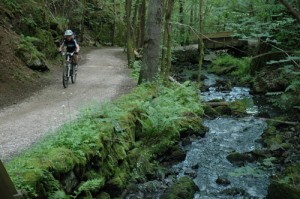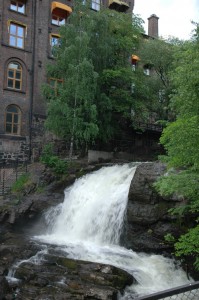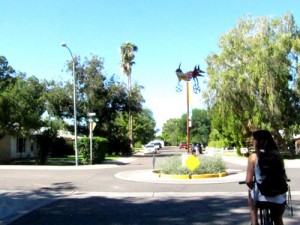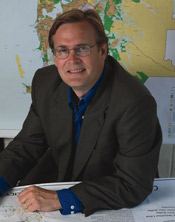October 29, 2013
A Thought Leader Series Piece
Note: This month Tim Beatley’s Biophilic Cities Launch exhibit featured student photography and videos from Senior Sustainability Scientist David Pijawka’s Sustainable Cities course. The work explores local examples of biophilia in neighborhoods, public parks, and vacant lots.
When I describe myself as a "biophilic urbanist" as I sometimes do, reactions vary from quizzical looks to knowing smiles. But almost always my title serves to open a conversation about the quality of contemporary life and the important role of nature in our lives.
The concept of biophilia was popularized by Harvard biologist and entomologist E.O. Wilson. To Wilson, biophilia is "the innately emotional affiliation of human beings to other living organisms. Innate means hereditary and hence part of ultimate human nature." We are carrying with us, so the argument goes, our ancient brains, and so no wonder that we are happier, more relaxed and productive in the presence of nature. Living a happy, meaningful life is certainly possible in the absence of nature, but much harder, as we increasingly understand that nature is not optional but essential.
Biophilic design has been well-articulated and convincingly adopted by architects, but relatively less attention has been given to understanding the implications of biophilia for the design and planning of urban neighborhoods, cities, and metropolitan regions, otherwise known as biophilic cities.
The Biophilic Cities project

In 2012 we began in earnest our Biophilic Cities Project, based in the University of Virginia’s School of Architecture with significant funding from the Summit Foundation and the George Mitchell Foundation. The project aims to better understand what biophilic cities are; what metrics we might use in defining and monitoring them; and what the current best practice is in supporting and expanding nature in U.S. cities and the world.
Much of this work has happened through our partner cities—cities where we have either developed formal agreements with city government to collaborate or where there are university researchers with whom we are working with. Study cities include Singapore; San Francisco, CA; Milwaukee, WI; Vitoria-Gasteiz, Spain; Portland, OR; and Wellington, New Zealand, among others. We have sought to collect basic data and geographical layers about the extent of nature in those cities, and to document the innovative policies, projects, and planning tools utilized, as well as the challenges faced and lessons learned in advancing an agenda of biophilic urbanism.
Each city is different

Each of our study cities is different with different constraints and physical, ecological, social, cultural, and political settings, as well as different histories and patterns of urbanization with which to contend.
Singapore is impressively pushing vertical greening and showing how high-density, high-rise living can accommodate nature through a variety of tools, from an innovative parks connector network to the use of a mix of subsidies, mandates, and research and development, to ensure that new buildings include nature.
San Francisco is inventing new kinds of small parks ("parklets," created from on-street car parking spaces), while Milwaukee shows the power of neighborhood-based nature centers.
Study cities as diverse as Oslo, Vitoria-Gasteiz, Singapore, and Milwaukee understand the power of daylighting and restoring rivers, streams, and shorelines, and finding ways to connect urban residents to them. Vitoria-Gasteiz and Wellington have a long tradition of successfully developing and expanding greenbelts.
Challenges to biophilic urbanism
How to foster a culture of curiosity about the nature that exists in a city and how to tangibly connect and engage residents remain serious concerns.
The city is home to many of Wilson has sometimes described as "micro-wildernesses," yet without some help from say, a portable microscope, it may be hard to discover these things. The innovative School of Ants engages school kinds in collecting and identifying ants and produced an urban guide to ants.
And it is not just the presence or absence of nature that defines a biophilic city; it is the ways and extent to which residents are directly engaged in nature and are knowledgeable and care about the nature around them. And here, there is much innovation, from citizen science to school-based education, to programs that create opportunities for urbanites to participate in activities such as camping in city parks during the summer months.
The next chapter

While we are already impressed with the variety of efforts in cities around the world, there remain a number of important questions: How much and what kind of nature is needed in cities? What combination of these natural experiences will deliver the greater health and psychological benefits? What is the minimum daily requirement of nature? What urban tools, techniques, and strategies will be most effective at ensuring nature exists in our urban future? Can cities be understood as engines for the conservation of biodiversity, and urban development designed in ways that positively restore and add to global biodiversity?
On October 17 - 20 we convened our Biophilic Cities Launch event, bringing together representatives from our partner cities to discuss and imagine future initiatives and work, and to form a peer network of biophilic cities—indeed a new model or paradigm of global urbanism that puts nature at the core.
There is more nature in cities than we tend to understand or recognize. From the microorganisms wafting on clouds, to the millions of migratory birds passing through the city, to the diversity of invertebrate life, the biodiversity in our urban midst is immense. Increasingly, we recognize, especially in the face of climate change, that cities can represent essential refugia, places where threatened biodiversity can be nurtured and fostered. A biophilic city is a place that restores.
About the author: Tim Beatley is a Teresa Heinz Professor of Sustainable Communities and Chair in the University of Virginia’s Department of Urban and Environmental Planning. Beatley is a foremost expert on biophilic cities and low-impact planning and design. The American Planning Association named one of Beatley’s books, "Ethical Land Use," one of the 100 Essential Books in Planning. His PBS documentary, The Nature of Cities, showcases real-life examples of biophilic design. Beatley believes that sustainable and resilient cities represent our best hope for addressing today’s environmental challenges.


